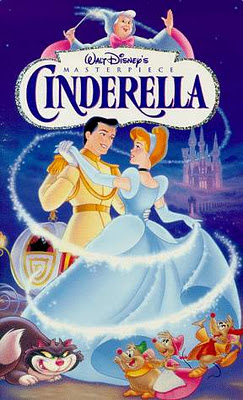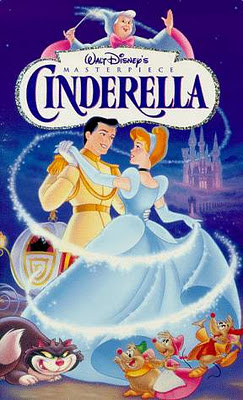This review by Olivia Bernal previously appeared at Bitch Flicks as part of our series on Animated Children’s Films.
 |
| Cinderella (1950) |
I would guess that in its long years of making animated features, Disney has made a mint on the princess formula. There is always a brooding prince, handsome, but distracted by his more worldly pursuits (i.e. war, evil, magic, etc.). There is a beautiful yet tragic young woman who is either on-her-knees humble, completely unaware of her high-class lineage, or else common as dirt. It is this woman’s duty to make trouble—stubbornly, stupidly, and innocently; the prince cleans up her mess, the audience rolling their collective eyes, lovingly amused.
In the case of Cinderella, the silly mistakes of losing a shoe and ignoring an expiring spell bring Prince Charming to Cinderella’s doorstep, ready to find his mate no matter how long it takes. This comes after a long and emotionally torturous journey on the part of Cinderella. In its beginning scenes, we see her struggle with housework under the ridiculous demands of her evil Stepmother and Stepsisters. She washes floors while singing prettily, the bubbles harmonizing her melody. It is revealed to us that she used to be rich and spoiled, but destiny wringed her into this incarnation – selfless, lovely, and dutiful. She is the better for it; look what fate made of those Stepsisters – loud, obnoxious, and ugly.
We see the Stepsisters’ true colors when, having been promised by her Stepmother to attend the Prince’s ball, Cinderella pieces together a gown from her real Mother’s dress and beads and cloth trashed by the Stepsisters and collected by Cinderella’s animals friends. As she cleans and cooks (in her Stepmother’s attempt to make her too late to attend the ball), the mice and birds sew together something passable for her to wear. The Stepsisters, recognizing their discarded materials, rip it apart and flounce off, their bustles comically bouncing after them.
It is shocking to see such a comely, self-possessed woman ripped apart as such. But a fairy godmother replaces the dress with a blue, glittering number, complete with absurd ear-covering headpiece. Cinderella floats into the ball and the rest is history. Beauty trumps power once again.
Watching Cinderella again for the first time since I was a child, it was amazing to me that time and again Disney portrays women as either bitches or victims. Ursula, Maleficent, Snow White’s Queen, the Queen of Hearts and of course Cinderella’s stepmother Lady Tremaine are all evil women, jealous of the beauty and innocence of their younger counterparts. One by one they seek to quell romance, passion, and everything else good from the lives of the eventual princesses by seeking power, wealth, and beauty of their own. Only a man can save these women from their pitiful disputes, damaging though they are. Perhaps the notion of a man wielding this type of power over a young, beautiful woman was a little too akin to rape for Disney’s taste. Either way, the Disney-fication of evil into an older, vindictive woman promotes an attitude that women are either a victim or seeking to be a victim; a mentality that when unleashed in the real world leads to horrific statements like, “She was asking for it.”
Newer Disney movies rely much less on this format; I think of such movies as Mulan, Beauty and the Beast, and Pocahontas whose end result of marriage contradicts a much more liberated adventure. In 1950, however, romance, passion, and entertainment could only be accomplished via marriage. True love was confirmed by a man deigning to step from his elevated social status to marry a woman of common birth. (A scheme that, as it usually turned out, wasn’t necessary because said princess is in fact rich or royal or whatever.) And marriage was enough to fill a plot. Jane Austen’s scheming ladies were a prototype for Disney princess movies. The goal is love, sure, but wealth and security sweeten the deal, too.
The problem I have most with Cinderella, though, is in the sweet density of Cinderella herself. “Have faith in your dreams and someday
/Your rainbow will come smiling through/
No matter how your heart is grieving
/If you keep on believing/
The dream that you wish will come true,” Cinderella croons as she prepares herself for another day of back-breaking, selfless labor. This kind of ignorant rhetoric endorses a blind acceptance of the status quo. Cinderella does not believe she can affect change in her own life. She will wait with faith and something good is bound to happen. Of course, as Disney shows us, it does; Prince Charming really does come and all is happily ever after. It negates a choice and, above all, this is the importance of the feminist movement – to allow the Cinderellas of the world to say “Fuck you” to all the evil power-mongers and be on their way – Prince or no. If women had just kept on believing, their dreams would definitely not have come true. Action in the form of choice is the truest path to liberation.
It is no coincidence that Cinderella was made in 1950. It was the era of writing the standards for the modern housewife; principles of which were impossible for any woman to attain without depression or at least a nasty drinking habit. This archetypal housewife has become the subject of so many books and movies (see The Hours, Far From Heaven, Revolutionary Road, etc.). The era was the springing board for Second Wave feminism. As nostalgia, it is still fun to watch a movie like Cinderella. Perhaps, if nothing else, we can enjoy these movies as a relic of the era – a document of history and ideas that are, luckily, past.
———-
Olivia Bernal is a public school English teacher from Kansas. She reviews books at The Independent Book Review.

